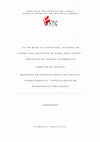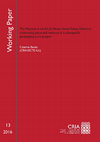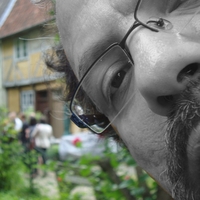Master's Thesis by Catarina Barata

Os cruzamentos entre cinema e dança são prolíficos desde que as duas formas de arte se encontrara... more Os cruzamentos entre cinema e dança são prolíficos desde que as duas formas de arte se encontraram pela primeira vez, bem no início da história do cinema. Na dança para o ecrã, as opções de realização assumem um papel preponderante na criação da peça e da cena. A questão de como filmar dança tem interessado criadores de diferentes áreas, que se têm dedicado a esse tipo de criação artística, em variados contextos de produção, do cinema à videodança.
Neste projeto de investigação através da prática, propõe-se explorar a adaptação da peça de dança originalmente concebida para palco In the Midst of Confusion, da companhia holandesa The 100Hands, dueto acerca da confiança e relações de poder, para o ecrã, com o objetivo de problematizar questões centrais na planificação e realização de dança para cinema. Pretende-se testar a importância da colaboração de especialistas de áreas diferentes numa área geneticamente intermedial, procurando saber de que modo as abordagens de peritos de diferentes áreas contribuem para a construção do objeto artístico.
Palavras-chave:dança em cinema, videodança, intermedialidades, relações de poder
The intersections between film and dance have been prolific since the two art forms met for the first time, early in the history of cinema. In dance for the screen, the film director’s options assume a leading role in the creation of the piece and the scene. The question of how to film dance has interested creators from different fields, who have dedicated themselves to this kind of artistic creation, in varied production contexts, from cinema to video dance.
In this practice based research project, we set to explore the adaptation of the play originally designed for stage In the Midst of Confusion, a duet about trust and power relations, by the Dutch company The 100Hands, to the screen, in order to problematize central issues in the planning and execution of dance for the screen. We aim to get an insight on the importance of the collaboration of specialists in different domains of knowledge in this genetically intermedial area, seeking to understand how the approaches of experts from different fields contribute to the construction of the artistic object.
Keywords: dance in film, video dance, intermedialities, power relations
Papers by Catarina Barata
The Lancet Regional Health - Europe

Societies
In this article, I address the issues of obstetric violence and racism in the Portuguese setting ... more In this article, I address the issues of obstetric violence and racism in the Portuguese setting of obstetric care. Based on data collected through interviews and participatory artistic creation, I analyze the perception of three Afro-Brazilian migrants about their perinatal experiences of obstetric care in the Portuguese public sector between 2013 and 2019. These women’s experiences have much in common with experiences of obstetric violence as narrated by Portuguese, non-racialized women. Despite this, certain aspects of their experience are related to their particular identification as Brazilian, migrant, and Black, such as xenophobic discrimination and their placement in systems of stratified reproduction, including a supposed tendency for birth by caesarean section, as well as self-policing behaviors because of the stereotype of Brazilian women as flirty. I consider a range of manifestations of obstetric violence and racism, from more overt forms to more covert ones, to analyze ...
International Journal of Gynecology & Obstetrics

Societies, 2022
In this article, I address the issues of obstetric violence and racism in the Portuguese setting ... more In this article, I address the issues of obstetric violence and racism in the Portuguese setting of obstetric care. Based on data collected through interviews and participatory artistic creation, I analyze the perception of three Afro-Brazilian migrants about their perinatal experiences of obstetric care in the Portuguese public sector between 2013 and 2019. These women’s experiences have much in common with experiences of obstetric violence as narrated by Portuguese, non-racialized women. Despite this, certain aspects of their experience are related to their particular identification as Brazilian, migrant, and Black, such as xenophobic discrimination and their placement in systems of stratified reproduction, including a supposed tendency for birth by caesarean section, as well as self-policing behaviors because of the stereotype of Brazilian women as flirty. I consider a range of manifestations of obstetric violence and racism, from more overt forms to more covert ones, to analyze how, in a country where racism and obstetric violence are only slowly beginning to be recognized as the norm, multiple discriminations intersect and have an impact on the experiences of women of their bodies in pregnancy, birth, and postpartum, including breastfeeding.

Revista (Con)textos, 2022
This article addresses the issue of obstetric violence and racism by analysing the perception and... more This article addresses the issue of obstetric violence and racism by analysing the perception and depiction of the birth experience of an Afro- Brazilian migrant in Portugal, materialised in an artwork that is part of the Gallery of Obstetric Experiences (Galeria das Experiências Obstétricas). In Corpo Partido ao Meio (“Body Broken in Half”), Maíra expresses her experience of disrespectful care, invasive unconsented interventions, and racism. The main focus of her artwork is the relationship between herself as a labouring woman and multiple health professionals who assisted her, organised around two main points: the interaction with a midwife who proffered racist tropes in a gentle way and the interaction with a physician who rudely performed unconsented interventions, while accompanied by medical students. Without disregarding other forms of obstetric violence that Maíra experienced, this paper focuses on a particular form of obstetric racism enunciated by the midwife. According to this midwife, Brazilian women’s bodies are unsuitable for birth due to miscegenation, thus leading to caesarean section. I question this affirmation and how the surgical intervention is presented as an obvious consequential way to address a supposed incapacity of Brazilian bodies to give birth. While Maíra’s experience is, in general, consonant with a wider setting of obstetric care where mistreatment of women is the norm, it echoes in particular an ingrained idea about race purity that is pervasive in a Portuguese society that is in denial about its own colonial past, translating into covert forms of racism in obstetric care as well as in other realms of life.

SSRN Electronic Journal
Background: Multi-country studies assessing the quality of maternal and newborn care (QMNC) durin... more Background: Multi-country studies assessing the quality of maternal and newborn care (QMNC) during the COVID-19 pandemic, as defined by WHO Standards, are lacking.Methods Women who gave birth in 12 countries of the WHO European Region from March 1, 2020 to March 15, 2021 answered an online questionnaire, including 40 WHO Standard-based quality measures. Findings: 21,027 women were included in the analysis. Among those who experienced labour (N=18,063), 49·9% (37·2%-60·7%) perceived a reduction in QMNC due to the COVID-19 pandemic, 41·8% (26·1%- 63·5%) experienced difficulties in accessing antenatal care, 62% (12·6%-99·0%) were not allowed a companion of choice, 31·1% (16·5%-56·9%) received inadequate breastfeeding support, 34·4% (5·2%-64·8%) reported health workers not always using protective personal equipment, and 31·8% (17·8%-53·1%) rated the number of health workers as “insufficient”. Episiotomy was performed in 20·1% (6·1%-66·0%) of spontaneous vaginal births and fundal pressure applied in 41·2% (11·5% -100%) of instrumental vaginal births. In addition, 23·9% women felt they were not treated with dignity (12·8%-59·8%), 12·5% (7·0%-23·4%) suffered abuse, and 2·4% (0·1%-26·2%) made informal payments. Findings were significantly worst among women with elective caesarean (CS) and emergency CS during labour (N=2,964). Multivariate analyses confirmed significant differences among countries, with Croatia, Romania, Serbia showing significant lower QMNC Indexes; younger women and those with operative births also had significant lower QMNC Indexes. Interpretation: Findings reveal large inequities in the QMNC across countries of the WHO European Region. Actions to reduce these inequities and promote high-quality, evidence-based, patient-centred respectful care for all mothers and newborns are urgently needed. Trial Registration: Study registration ClinicalTrials.gov Identifier: NCT04847336. Funding: The study was financially supported by the Institute for Maternal and Child Health IRCCS Burlo Garofolo, Trieste, Italy. Declaration of Interest: None to declare. Ethical Approval: The study was approved by the Institutional Review Board of the coordinating centre: the IRCCS Burlo Garofolo Trieste (IRB-BURLO 05/2020 15.07.2020). The study protocol was also reviewed and approved by the ethical committees of three other countries to comply with local regulations: Portugal (Instituto de Saude Publica da Universidade do Porto, CE20159); Norway (Norwegian Regional Committee for Medical Research Ethics, 2020/213047) and Germany (Bielefeld University ethics committee, 2020-176).
In the face of the pandemic, we have been forced to adopt strategies in order to balance our doct... more In the face of the pandemic, we have been forced to adopt strategies in order to balance our doctoral work at the same time as caring for our families. As the digital turn has pervaded both social and academic milieus, we consider the potentials and shortcomings of remote interactions and approaches and how they have impacted our work and personal lives. We focus on the challenges of balancing paid work and the unpaid work of care, as well as considering potential changes to the concept of care in terms of building a caring culture.
COVID-19 and SRH/MNH: a Curated Online Collection for Medical Anthropology Quarterly, 2020
The COVID-19 pandemic has made the highly medicalized and interventionist approach in which facil... more The COVID-19 pandemic has made the highly medicalized and interventionist approach in which facility-based birth was happening in Portugal before the outbreak more acute. In a system where personal choice and self-determination are not well established, their possibility is easily overridden in the face of what is perceived as a dramatic threat to life. This piece considers both women’s voiced concern of the impact of the COVID-19 containment measures readily implemented in MNH care provision, which focus exclusively on control and minimization of risk of contagion at all costs to the detriment of positive perinatal experiences, and the role of civil society organizations in denouncing and struggling for the reinstatement of childbirth rights at health facilities.
Overview of anthropological production with the southwest coast of Portugal (Odemira) as field fr... more Overview of anthropological production with the southwest coast of Portugal (Odemira) as field from late 19th century to the present (2013).
Drafts by Catarina Barata

Based on the author’s field experience from the participatory art project “The Museum is Us All”,... more Based on the author’s field experience from the participatory art project “The Museum is Us All”, the article focuses on the paramount role that art can play in the creation of collective memories and sense of belonging to a place. Through the creative transformation of collective and individual patrimonial elements into art pieces, and through the embodied lived experiences and sharing of affective memorable moments, the transformative power of the arts is a privileged means to create senses of communal commitment and to elaborate imagined realities. However the obvious positive results of this kind of project in the collective self-esteem, temporarily creating a feeling of community and sharing, the one-off nature of this kind of project, depending on the opportunistic agendas of public political institutions, inevitably bears inconsistent results. As participation is appropriated by social inclusion discourses, current debates about the instrumentation of participatory art in the context of neoliberal acts of governance cannot go unaddressed.











Uploads
Master's Thesis by Catarina Barata
Neste projeto de investigação através da prática, propõe-se explorar a adaptação da peça de dança originalmente concebida para palco In the Midst of Confusion, da companhia holandesa The 100Hands, dueto acerca da confiança e relações de poder, para o ecrã, com o objetivo de problematizar questões centrais na planificação e realização de dança para cinema. Pretende-se testar a importância da colaboração de especialistas de áreas diferentes numa área geneticamente intermedial, procurando saber de que modo as abordagens de peritos de diferentes áreas contribuem para a construção do objeto artístico.
Palavras-chave:dança em cinema, videodança, intermedialidades, relações de poder
The intersections between film and dance have been prolific since the two art forms met for the first time, early in the history of cinema. In dance for the screen, the film director’s options assume a leading role in the creation of the piece and the scene. The question of how to film dance has interested creators from different fields, who have dedicated themselves to this kind of artistic creation, in varied production contexts, from cinema to video dance.
In this practice based research project, we set to explore the adaptation of the play originally designed for stage In the Midst of Confusion, a duet about trust and power relations, by the Dutch company The 100Hands, to the screen, in order to problematize central issues in the planning and execution of dance for the screen. We aim to get an insight on the importance of the collaboration of specialists in different domains of knowledge in this genetically intermedial area, seeking to understand how the approaches of experts from different fields contribute to the construction of the artistic object.
Keywords: dance in film, video dance, intermedialities, power relations
Papers by Catarina Barata
Drafts by Catarina Barata
Neste projeto de investigação através da prática, propõe-se explorar a adaptação da peça de dança originalmente concebida para palco In the Midst of Confusion, da companhia holandesa The 100Hands, dueto acerca da confiança e relações de poder, para o ecrã, com o objetivo de problematizar questões centrais na planificação e realização de dança para cinema. Pretende-se testar a importância da colaboração de especialistas de áreas diferentes numa área geneticamente intermedial, procurando saber de que modo as abordagens de peritos de diferentes áreas contribuem para a construção do objeto artístico.
Palavras-chave:dança em cinema, videodança, intermedialidades, relações de poder
The intersections between film and dance have been prolific since the two art forms met for the first time, early in the history of cinema. In dance for the screen, the film director’s options assume a leading role in the creation of the piece and the scene. The question of how to film dance has interested creators from different fields, who have dedicated themselves to this kind of artistic creation, in varied production contexts, from cinema to video dance.
In this practice based research project, we set to explore the adaptation of the play originally designed for stage In the Midst of Confusion, a duet about trust and power relations, by the Dutch company The 100Hands, to the screen, in order to problematize central issues in the planning and execution of dance for the screen. We aim to get an insight on the importance of the collaboration of specialists in different domains of knowledge in this genetically intermedial area, seeking to understand how the approaches of experts from different fields contribute to the construction of the artistic object.
Keywords: dance in film, video dance, intermedialities, power relations